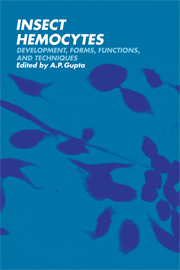Book contents
- Frontmatter
- Contents
- Preface
- List of contributors
- Part I Development and differentiation
- Part II Forms and structure
- Part III Functions
- Part IV Techniques
- 17 Identification key for hemocyte types in hanging-drop preparations
- 18 Insect hemocytes under light microscopy: techniques
- 19 Techniques for total and differential hemocyte counts and blood volume, and mitotic index determinations
- 20 Hemocyte techniques: advantages and disadvantages
- 21 Light, transmission, and scanning electron microscopic techniques for insect hemocytes
- 22 Histochemical methods for hemocytes
- Indexes
22 - Histochemical methods for hemocytes
Published online by Cambridge University Press: 04 August 2010
- Frontmatter
- Contents
- Preface
- List of contributors
- Part I Development and differentiation
- Part II Forms and structure
- Part III Functions
- Part IV Techniques
- 17 Identification key for hemocyte types in hanging-drop preparations
- 18 Insect hemocytes under light microscopy: techniques
- 19 Techniques for total and differential hemocyte counts and blood volume, and mitotic index determinations
- 20 Hemocyte techniques: advantages and disadvantages
- 21 Light, transmission, and scanning electron microscopic techniques for insect hemocytes
- 22 Histochemical methods for hemocytes
- Indexes
Summary
Introduction
Histochemical techniques are designed to give information about the chemical composition of tissues. There is a vast range of techniques that can be used for the location and identification of nucleic acids, carbohydrates, lipids, proteins, enzymes, and some inorganic ions. The subject is complex, and there are many pitfalls for the inexpert. For many biologists, to do some histochemistry is merely to follow the procedures, as outlined, at the end of a histochemistry textbook–it all seems so simple! But many procedures are inadequately described; often, for example, no source is given for the vital reagent that it is essential to purchase from a particular supplier, and the interpretation of a positive result may be described so categorically as to be misleading or only half true.
The techniques that have been most frequently used on smears of insect hemocytes are primarily those for localizing carbohydrates and lipids, as the main purpose has been the identification of the chemical nature of the many granules and droplets that can be seen in certain types of hemocytes in histological preparations or by phase-contrast microscopy. For this reason, I shall concentrate on these methods in this chapter.
Fixation
An important prerequisite for the majority of histochemical tests is the fixation of the tissue. In general, only proteins are completely fixed, i.e., rendered insoluble and resistant to subsequent procedures, by the commonly used fixatives. Carbohydrates are not fixed, but are retained in the tissues by virtue of the enmeshing proteins. Lipids, in general, are not fixed, and most are still readily soluble in alcohols and other organic solvents.
- Type
- Chapter
- Information
- Insect HemocytesDevelopment, Forms, Functions and Techniques, pp. 581 - 599Publisher: Cambridge University PressPrint publication year: 1979
- 2
- Cited by



